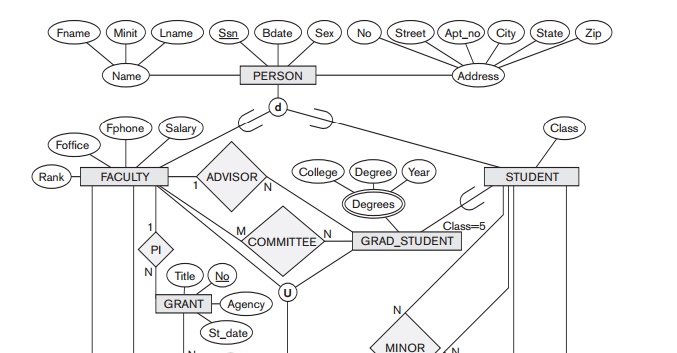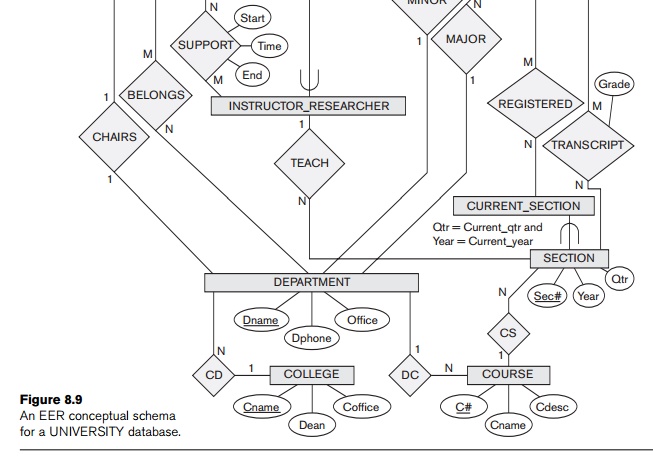Chapter: Fundamentals of Database Systems : Conceptual Modeling and Database Design : The Enhanced Entity-Relationship (EER) Model
A Sample UNIVERSITY EER Schema, Design Choices, and Formal Definitions
A Sample UNIVERSITY EER Schema, Design Choices, and Formal Definitions
In this section, we first give an example of a database schema in the
EER model to illustrate the use of the various concepts discussed here and in
Chapter 7. Then, we discuss design choices for conceptual schemas, and finally
we summarize the EER model concepts and define them formally in the same manner
in which we formally defined the concepts of the basic ER model in Chapter 7.
1. The UNIVERSITY
Database Example
For our sample database application, consider a UNIVERSITY database that keeps track of students and their majors, transcripts,
and registration as well as of the university’s course offerings. The database
also keeps track of the sponsored research projects of faculty and graduate
students. This schema is shown in Figure 8.9. A discussion of the requirements
that led to this schema follows.
For each person, the database maintains information on the person’s Name
[Name], Social Security number [Ssn],
address [Address], sex [Sex], and birth date [Bdate]. Two subclasses of the PERSON entity type are identified: FACULTY and STUDENT. Specific attributes of FACULTY are rank
[Rank] (assistant, associate, adjunct, research, visiting, and so on), office
[Foffice], office phone [Fphone], and salary [Salary]. All faculty members are related to the academic department(s) with
which they are affiliated [BELONGS] (a faculty member can be
associated with several departments, so the relationship is M:N). A specific
attribute of STUDENT is [Class] (freshman=1, sophomore=2, ..., graduate student=5). Each STUDENT is also related to his or her major and minor departments (if known) [MAJOR] and [MINOR], to the course sections he or she is currently attending [REGISTERED], and to the courses completed [TRANSCRIPT]. Each TRANSCRIPT instance includes the grade the student received [Grade] in a section of a course.
GRAD_STUDENT is a subclass of STUDENT, with the defining predicate Class = 5.
For each graduate student, we keep a list of
previous degrees in a composite, multi-valued attribute [Degrees]. We also relate the graduate student to a faculty advisor [ADVISOR] and to a thesis committee [COMMITTEE], if one
exists.
An academic department has the attributes name [Dname], telephone [Dphone], and office number [Office] and is related to the faculty member who is its chairperson [CHAIRS] and to the college to which it belongs [CD]. Each
college has attributes college name [Cname], office
number [Coffice], and the name of its dean [Dean].
A course has attributes course number [C#], course
name [Cname], and course description [Cdesc].
Several sections of each course are offered, with each section having the
attributes section number [Sec#] and the year and quarter in
which the section was offered ([Year] and [Qtr]).10 Section numbers uniquely
identify each section. The sections being offered during the current quarter
are in a subclass
CURRENT_SECTION of
SECTION, with the defining predicate Qtr = Current_qtr and
Year = Current_year. Each section is related to the instructor who taught or is teach-ing
it ([TEACH]), if that instructor is in the database.
The category INSTRUCTOR_RESEARCHER is a subset of the union of FACULTY and GRAD_STUDENT
and includes all faculty, as well as graduate
students who are sup-ported by teaching or research. Finally, the entity type GRANT keeps track of research grants and contracts awarded to the university.
Each grant has attributes grant title [Title], grant
number [No], the awarding agency [Agency], and the starting


date [St_date]. A grant is related to one principal investigator [PI] and to all researchers it supports [SUPPORT]. Each
instance of support has as attributes the starting date of support [Start], the ending date of the support (if known) [End], and the percentage of time being spent on the project [Time] by the researcher being supported.
2. Design Choices for
Specialization/Generalization
It is not always easy to choose the most appropriate conceptual design
for a database application. In Section 7.7.3, we presented some of the typical
issues that confront a database designer when choosing among the concepts of
entity types, relationship types, and attributes to represent a particular
miniworld situation as an ER schema. In this section, we discuss design
guidelines and choices for the EER concepts of specialization/generalization
and categories (union types).
As we mentioned in Section 7.7.3, conceptual database design should be
considered as an iterative refinement process until the most suitable design is
reached. The fol-lowing guidelines can help to guide the design process for EER
concepts:
In general, many specializations
and subclasses can be defined to make the conceptual model accurate. However,
the drawback is that the design becomes quite cluttered. It is important to
represent only those subclasses that are deemed necessary to avoid extreme
cluttering of the conceptual schema.
If a subclass has few specific
(local) attributes and no specific relationships, it can be merged into the
superclass. The specific attributes would hold NULL values
for entities that are not members of the subclass. A type attribute could specify whether an entity is a member of the
subclass.
Similarly, if all the subclasses
of a specialization/generalization have few specific attributes and no
specific relationships, they can be merged into the superclass and replaced
with one or more type attributes that
specify the sub-class or subclasses that each entity belongs to (see Section
9.2 for how this criterion applies to relational databases).
Union types and categories should
generally be avoided unless the situation definitely warrants this type of
construct, which does occur in some practical situations. If possible, we try
to model using specialization/generalization as discussed at the end of Section
8.4.
The choice of disjoint/overlapping and total/partial constraints on
specialization/generalization is driven by the rules in the miniworld being
modeled. If the requirements do not indicate any particular constraints, the
default would generally be overlapping and partial, since this does not specify
any restrictions on subclass membership.
As an example of applying these guidelines, consider Figure 8.6, where
no specific (local) attributes are shown. We could merge all the subclasses
into the EMPLOYEE entity type, and add the following attributes to EMPLOYEE:
An attribute Job_type whose value set {‘Secretary’, ‘Engineer’, ‘Technician’} would indicate
which subclass in the first specialization each employee belongs to.
An attribute Pay_method whose value set {‘Salaried’, ‘Hourly’} would indicate which subclass in
the second specialization each employee belongs to.
An attribute Is_a_manager whose value set {‘Yes’, ‘No’} would indicate whether an individual
employee entity is a manager or not.
3. Formal Definitions
for the EER Model Concepts
We now
summarize the EER model concepts and give formal definitions. A class is a set or
collection of entities; this includes any of the EER schema constructs of group
entities, such as entity types, subclasses, superclasses, and categories. A subclass S is a class whose
entities must always be a subset of the entities in another class, called the superclass
C of the superclass/subclass (or IS-A)
relationship. We denote such a
relationship by C/S. For such a
superclass/subclass relationship, we must always have
S
⊆ C
A specialization Z = {S1, S2, ..., Sn} is a set of subclasses that have the same
super-class G; that is, G/Si
is a superclass/subclass relationship for i
= 1, 2, ..., n. G is called a generalized
entity type (or the superclass
of the specialization, or a generalization
of the subclasses {S1, S2,
..., Sn} ). Z
is said to be total if we always
(at any point in time) have

Otherwise,
Z is said to be overlapping.
A
subclass S of C is said to be predicate-defined
if a predicate p on the attributes of
C is used to specify which entities
in C are members of S; that is, S = C[p], where C[p] is the set of
entities in C that satisfy p. A subclass that is not defined by a
predicate is called user-defined.
A
specialization Z (or generalization G) is said to be attribute-defined if a predicate (A = ci), where
A is an attribute of G and ci is a constant value from the domain of A, is used to specify membership in each subclass Si in Z. Notice that if ci ≠ cj for i ≠ j, and A is a single-valued attribute, then the specialization will be disjoint.
A category T is a class that is a subset of the union of n defining superclasses D1, D2, ..., Dn, n > 1, and is formally specified as follows:
T ⊆ (D1 ∪ D2 ... ∪ Dn)
A
predicate pi on the
attributes of Di can be
used to specify the members of each Di
that are members of T. If a predicate
is specified on every Di,
we get
T = (D1[p1] ∪ D2[p2] ... ∪ Dn[pn])
We should
now extend the definition of relationship
type given in Chapter 7 by allowing any class—not only any entity type—to
participate in a relationship. Hence, we should replace the words entity type with class in that definition. The graphical notation of EER is
consistent with ER because all classes are represented by rectangles.
Related Topics